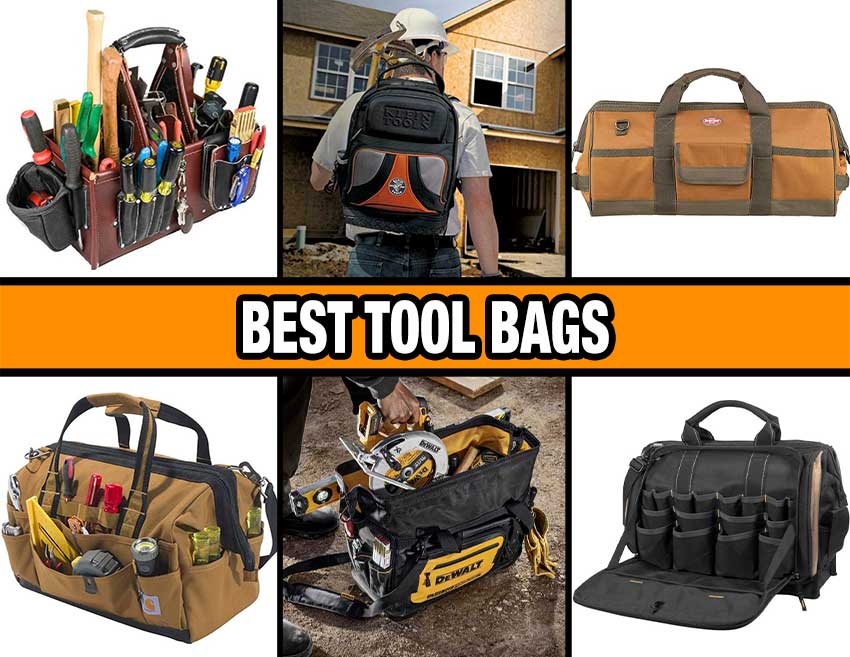Whether it’s for permanent storage or just for bringing tools inside for a DIY project, a high-quality tool bag is a must. These bags are lightweight but durable, allowing users to load them with various tools for easy transport. Moreover, they have numerous pockets and features for convenience, making them a great option for pros and DIYers.
But there are a lot of tool bags, so it can be hard to tell which models are worth the money. In this guide, we’ll take a deep dive into these tool storage options to help readers choose the best tool bag for their needs.
Our Top Picks
- Best Overall: Klein Tool Bag Backpack 55421
Jump to this Tool Bag ↓ - Best for Carpenters: Occidental Leather Master Carpenter Case 5588
Jump to this Tool Bag ↓ - Best for Mechanics: Bucket Boss Longboy Tool Bag 60024
Jump to this Tool Bag ↓ - Best for Handymen: Carhartt Onsite Tool Bag 8926010501
Jump to this Tool Bag ↓ - Best for Techs and Electricians: CLC Custom Leathercraft 50-Pocket Tool Bag 1539
Jump to this Tool Bag ↓ - Best Roller Tool Bag: Klein Tools 55452RTB Tool Bag
Jump to this Tool Bag ↓ - Best for Power Tools: Dewalt Tool Bag 20-inch DWST560104
Jump to this Tool Bag ↓
Also In This Article
- Best Tool Bag Buying Guide
- Frequently Asked Questions
- Related Content
- Why You Can Trust Pro Tool Reviews
How We Picked the Best Tool Bag
We take our tool bags very seriously. Most people invest a lot of money into their tools over many years, so the bag they store or transport in them must be up to the task. That said, we made sure that any models we chose could store tools securely and safely. We used our first-hand experiences and performed extensive research to create this list.
First, we considered the different types of people that need tool bags. Then we considered the tools they use and the storage options they would need. We also know material matters, so we researched the top materials and fabrics to find the most reliable bags. Once we chose all the important features and suitable materials, we compiled a list of bags we thought could do the trick.
Finally, we compared our list of bags. We compared their pricing, their functionality, sizes, and transportation options. Those that passed our scrutiny and offered enough value were added to this list and given awards based on their strengths or best uses.
Best Overall Tool Bag
Klein 55421 Tool Bag Backpack
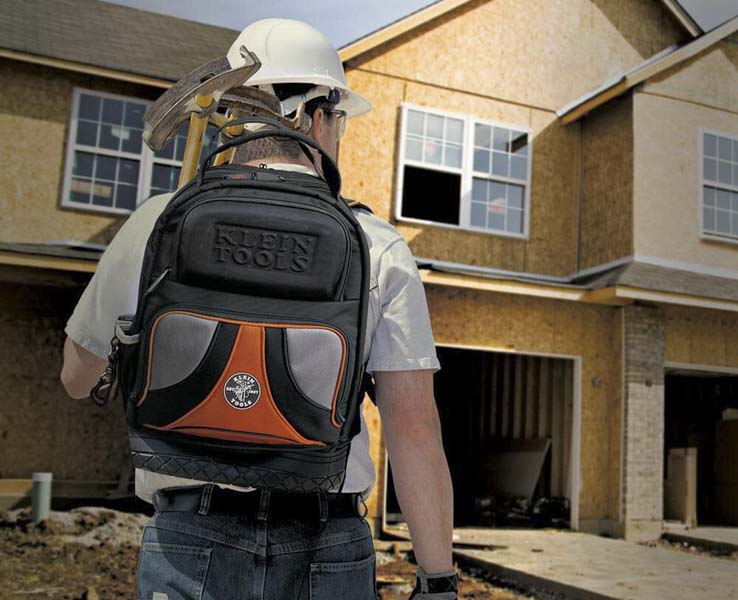
Our pick for the best tool bag overall is the Klein 55421 Tool Bag Backpack. This bag has everything you could want from a tool bag, making storage easy and organized. It features 39 pockets overall, including pockets for meters, hand tools, drill bits, marking tools, and a range of other items. However, power tool storage is relatively limited. It has a zippered pocket for safety glasses as well.
This bag is made from heavy-duty, ballistic weave nylon with a plastic molded bottom, allowing it to hold a ton of weight and resist tearing and water infiltration. It also has wide, padded straps with a non-slip texture to make carrying the bag easier and more comfortable, even when fully loaded. Klein also lined the bag’s interior with an orange fabric to increase contrast and visibility.
Key Features
- Material: 1680D ballistic weave nylon
- Pockets: 39
- Size: 14.5 inches long, 7.25 inches wide, 20 inches high
Pros
- Heavy-duty nylon material and molded plastic bottom for durability
- Plenty of pockets for tools in both zippered and pouch-style
- Wide, padded, non-slip shoulder straps for comfortable carry
Cons
- Not a lot of room for a drill or other power tools
Price: $99.97
Best Tool Bag For Carpenters
Occidental Leather Master Carpenter Case 5588
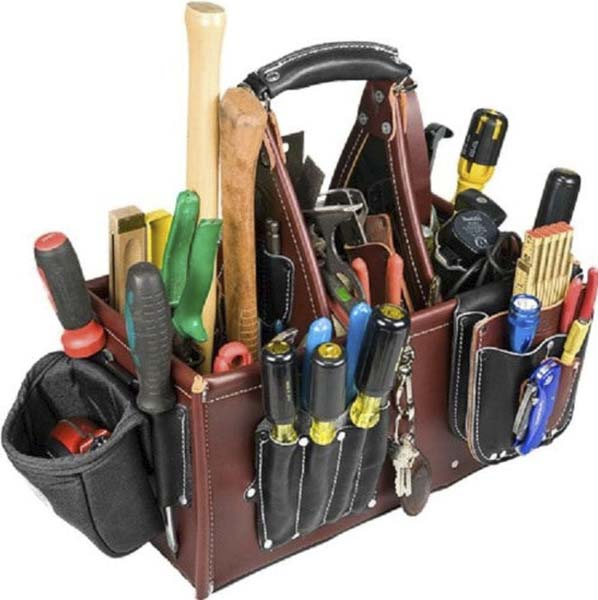
Occidental Leather is a name that all professional carpenters know and respect, and this Master Carpenter Case bag is a perfect example. This bag is made from the same leather that the company uses for its long-lasting tool bags, as well as a rubber bottom for water resistance and long-term durability, ensuring that it’s a “buy once, cry once” scenario—it is pretty expensive.
This carpenter’s tool bag features 3 compartments and 45 overall pockets. Users can store everything from screwdrivers, hammers, and pry bars to nail sets, chisels, and other small tools. It features pouches designed specifically for carpenters (the rafter square sleeve, for example) and has a tall, leather-wrapped handle for easy transport. There are even plenty of safe storage options for sharp tools like chisels and knives, as well as clip-on bags and the popular Oxy Tool Shields.
Key Features
- Material: Leather
- Pockets: 3 compartments with 45 pockets
- Size: 15.5 inches long, 8.5 inches wide, 8 inches high
Pros
- Made from the same long-lasting leather that Occidental uses for tool belts
- Features upright storage compartments so nothing gets lost
- Safe storage for sharp items like chisels and knives
Cons
- It’s by far the most expensive option on the list
Price: $448
Best Tool Bag For Mechanics
Bucket Boss Longboy Tool Bag 60024
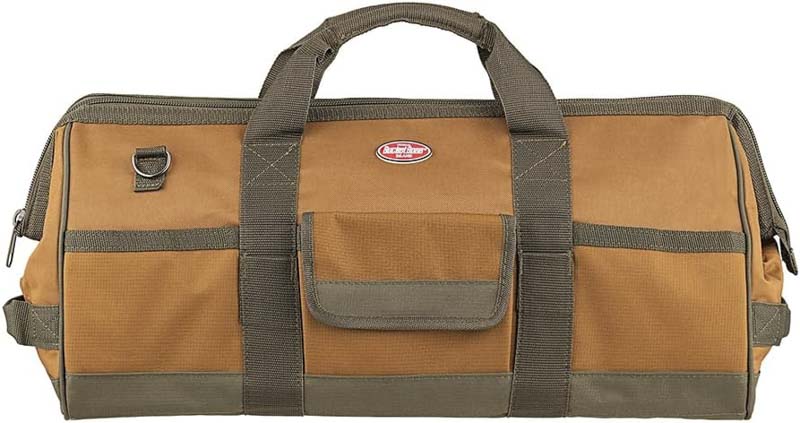
Most mechanics work in a shop, not far from their tool box. But on the occasion that they have to take their tools on the road for a repair, they need a bag that’s long enough to house their heavy-duty wrenches, socket sets, breaker bars, cheater pipes, and more, and this bag from Bucket Boss can do it. The Longboy 16-pocket tool bag measures 24 inches long, allowing these pros to put those heavy-duty tools in the bottom and then fill in the other 16 pockets with smaller tools.
Size isn’t the only thing that the Longboy has going for it. It’s made from ripstop polyester and its handles are rolled and stretched under the bag to improve its durability (though it doesn’t have a rubber, plastic, or water-resistant bottom). The Gatemouth opening is also a plus, as it allows users to unzip the bag and look for tools with one hand, as the mouth stays open for easy tool access.
Key Features
- Material: Ripstop polyester
- Pockets: 16 pockets
- Size: 24 inches long, 10 inches wide, 11 inches high
Pros
- Perfect size for a socket set, breaker bars, and other important mechanics tools
- Gatemouth opening stays open when unzipped for plenty of access, even with one and
- Main handles run under the bag for increased support
Cons
- It doesn’t have a water-resistant or tear-resistant bottom
Price: $45.99
Best Tool Bag For Handymen
Carhartt Onsite Tool Bag 8926010501
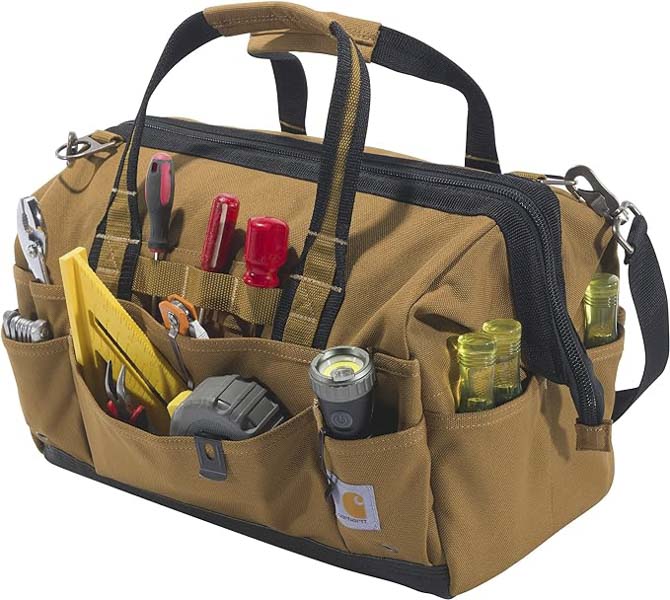
Handymen (and women) who carry a lot of tools to and from the job and who like to keep them organized should consider the Carhartt Onsite Tool Bag. It’s made from durable 1200d polyester treated with Carhartt’s Rain Defender coating, helping it resist water. It also features a Duravax-coated bottom to improve water resistance, puncture resistance, and overall durability. It also has thick straps with padded handles to improve comfort.
This bag has 25 pockets with plenty of structure, allowing them to hold taller items in place securely. It can handle smaller hand tools, bits, and marking tools on the outside and has several deep interior pockets for pliers, meters, and other items. It also has a large interior center pocket that can hold a drill, though it might be a little too small for many more power tools.
Key Features
- Material: 1200d polyester
- Pockets: 25
- Size: 14 inches long, 10.5 wide, 9 inches high
Pros
- Durable 1200d polyester with Rain Defender treatment and a Duravax-coated base
- Plenty of pockets and an internal metal frame to ensure the mouth stays open
- Comfortable padded handles make carrying the loaded bag easy
Cons
- It’s a little small for carrying more than a drill
Price: ~ $75
Best Tool Bag for Technicians and Electricians
CLC Custom Leathercraft 50-Pocket Tool Bag 1539
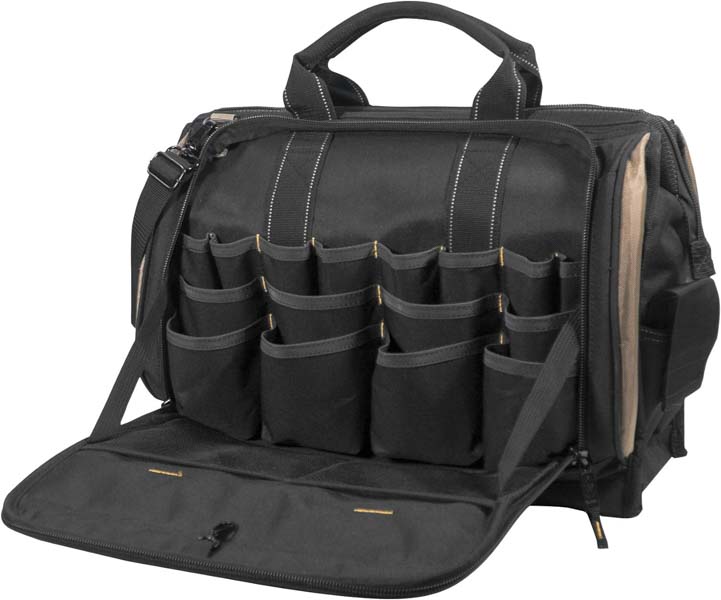
Whether it’s organizing meters, testers, screwdrivers, pliers, flashlights, pens, electronic devices, or anything else a technician or electrician might need to bring on-site, the CLC 50-pocket Tool Bag is a great fit. This bag is made from durable polyester, with comfortable padded handles stitched down to the bottom of the bag, improving overall durability. Unfortunately, it doesn’t have a water-resistant or puncture-resistant coating underneath, but the bottom is double-layered.
This model from CLC has 50 pockets, allowing technicians to organize their hand tools in two drop-down zippered front pockets, with a tiered designed to promote visibility. There are also pockets on the front for a notepad or invoice book. The interior is roomy enough to handle a drill and an impact driver, or even a drill and a compact sawzall, too.
Key Features
- Material: Heavy-duty polyester
- Pockets: 50
- Size: 18 inches long, 7 inches wide, 14 inches high
Pros
- Plenty of pockets for carrying an entire technician’s hand tool set
- Exterior pockets are suitable for note pads and invoice slips
- Interior pocket is large enough for more than one drill
- Features comfortable padded handle for comfortable carrying
Cons
- Bottom doesn’t have a tear- or water-resistant coating
Price: $119
Best Roller Tool Bag
Klein Tools 55452RTB Tool Bag
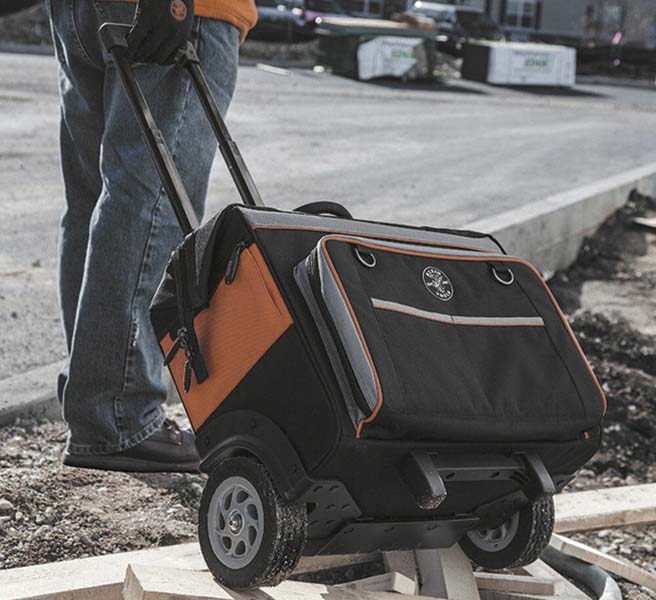
Rather than carrying your tools where they need to go, what about a tool bag that allows you to roll them? The Klein Tools 55452RTB Tool Bag is up for the job, with its 200-pound capability and 6-inch wheels, it can handle lots of tools and terrain. It features rolled top handles and a telescoping handle for easy transport.
This model features durable ballistic weave nylon as well as a molded base. It has 24 total pockets including those inside the bag and those behind the zippered front pocket. The metal-framed opening is easy to access, as well. However, it is expensive, so it’s best for pros who will use it frequently.
Key Features
- Material: Ballistic weave nylon
- Pockets: 24 pockets
- Size: 20 inches long, 11 inches wide, 16.3 inches tall
Pros
- Design is load-tested up to 200 pounds for plenty of tool transporting capability
- Features rugged 6-inch wheels for dragging it along smooth floors or rough job sites
- Metal-framed opening stays open for easy access to the large interior pocket
- Pockets on the inside of the bag as well as behind the zippered drop-down front pocket
Cons
- Expensive, so it’s probably best for pros who will use it every day
Price: $199.97
Best Tool Bag For Power Tools
DeWalt Tool Bag 20-inch DWST560104
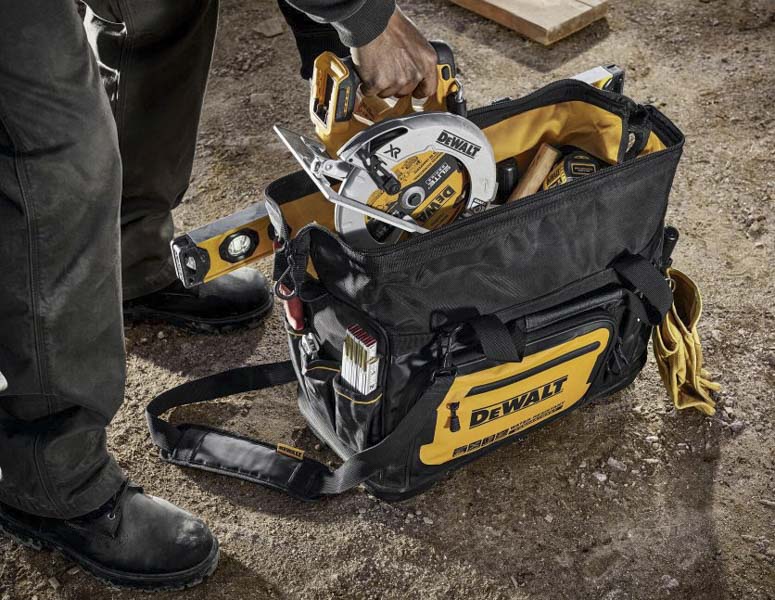
Shoppers looking for the best tool bag to bring power tools back and forth to the job should consider the DeWalt 20-inch Tool Bag. This model features a hard-molded bottom for durability and waterproofing, as well as durable polyester fabric for the body and pockets. It also has a waterproof, zippered pocket, which might be a bit of a gimmick, as it seems like the rest of the bag can’t handle weather exposure.
But down to what makes this model perfect for power tools: capacity. This model has a wide-open center section with a metal frame to keep it open. It has several pockets inside, including one specifically for a drill and one for a battery, though there are plenty of other spaces for these items, too. Users will be able to store other tools and chargers as well.
Key Features
- Material: Polyester
- Pockets: 33 pockets
- Size: 20 inches long, 11 inches wide, 12 inches high
Pros
- Large interior compartment has pockets designed specifically for a drill and battery
- Plenty of room on the interior for several power tools and a charger
- Features a molded base for waterproofing and durability
Cons
- Water-resistant pocket might be a bit of a gimmick
Price: $79.98
Best Tool Bag Buying Guide
Tool bags are great because they’re lighter and typically easier to organize than a tool box. But that doesn’t mean that all tool bags make the cut. The following are some of the most critical factors when choosing the best tool bag for your needs or trade.
Material and Durability
Importance of High-Quality Materials
A tool bag should include high-quality materials, or it will fail in short order. The best materials for a tool bag are nylon, polyester, and Cordura, which is a heavy-duty version of nylon. There are also bags made from heavy-duty canvas that can last for years.
It’s also a good idea to pay attention to the material on the bottom of the bag. Many of the best bags have rubber, plastic, or leather reinforcement underneath the bag to support more weight, prevent tearing, and add a layer of water resistance to the bag. This portion of the bag is just as important as the pockets and straps, so it’s worth looking out for the right material underneath.
Durability for Long-Term Use
Certain factors will help determine the durability of a tool bag. Stitching patterns like double or triple stitching or tack stitching for reinforcement will help the bag resist tearing. Also, rivets at stress points are a determining factor. Heavy-duty nylon or metal buckles and clips will last longer than plastic, as well.
Size and Capacity
Step One: Assessing Your Tool Collection
You have to understand how many tools you have that should be stored in a tool bag. As a general rule, tool bags are for permanent storage of hand tools such as screwdrivers, utility knives, hammers, pliers, pry bars, chisels, drill bits, and marking tools like tape measures, small levels, pencils, pens, markers, and the like. They’re not meant for long-term storage of drills or reciprocating saws—these usually come with bags.
Our suggestion is to lay the hand tools out on a table and assess them. Count the type of tools you have and the types of pockets they fit in. Screwdrivers are best in small slotted pockets, while a deep pocket is better for a few pairs of pliers, and hammers can sit in the bottom of the main pocket.
Also, for some pros, there may be a need for organizing meters and testing equipment. These tools are usually quite expensive and maybe even sensitive, so it’s best to either keep them in their carrying cases in the main pocket or find specific pockets for them.
Step 2: Optimal Size for Your Needs
Now that you have a better understanding of the tools you’ll want to store in the new tool bag, start shopping for a proper solution. Consider how many small slotted pockets you need, how many pockets for wrenches, drill bit cases, and instruments, and other tools tallied up in the first step. Then, look for a tool bag that fits those needs. Don’t shop blind.
Compartments and Organization
Importance of Multiple Compartments
There’s something satisfying about getting into a flow while working on a project, but having a disorganized tool bag can prevent that from ever happening. A tool bag with individual pockets allows DIYers and pros to quickly find their tools and get to work.
Also, individual compartments are helpful to prevent missing tools. Once the job is over, an empty pocket likely means a tool is missing, so the person should head back to the job to look for the tool.
Finally, individual pockets keep tools safe and, when it matters, sharp. Throwing chisels in the bottom of a tool bag is almost as bad as driving one into a nail. When kept in their own pockets, they’re safer and sharper when it comes time to use them.
Customization Options for Organization
Another handy aspect to tool bags is that their organization and setup can be customized according to the job at hand. For instance, if a building mechanic knows they’re heading to an HVAC repair, they can grab a few meters, screwdrivers, and pliers and place them in pockets toward the top or front of the bag. If they’re heading to a carpentry project, they can stash some utility knives, marking tools, measuring tools, and pry bars in pockets that are easy to find.
Portability and Comfort
Types of Handles and Straps
Handles and straps are one of the most important factors when looking for the best tool bag. For handles, look for rolled, rounded handles, or handles that are wrapped in leather or a cushioned strap. This will prevent the weight of the tools from digging into the hand while carrying.
Shoulder straps are equally as important. Shoulder straps need to be thickly padded, whether there is one strap or two. They should also be adjustable so each user can find the perfect fit for their needs.
Weight Distribution for Ease of Carrying
Tool bags get heavy, so proper weight distribution is key. Above, we discussed padded adjustable straps. These pads and wide straps make the distribution of all of the weight over a larger portion of the body possible, so again, it’s important to look for a proper strap. Shoppers who choose thin, cheap nylon straps will use them once and never again.
Brand Reputation
There are some top-notch brands on the market that customers will pay slightly more for. But these are assured to provide the best quality. When it comes to tool bags, Klein has been making the best basic models for decades but has also started offering more organized models. Also, Dewalt, Milwaukee, and CLC are popular brands.
Uses of Tool Bags
At their most basic, tool bags are used to carry important tools from the shop or garage to the job site. But there may be some additional or specific uses for tool bags that shoppers haven’t thought of.
Professional vs. DIYers
Professionals and DIYers might have different needs for a tool bag. For instance, pros might need something overbuilt and sturdy so they can take it in and out of the truck five or six days a week, depending on their job. For DIYers, something a little lighter with plenty of organization to hold all of their tools is a good move, and since they typically only see weekend use, they don’t have to be quite as overbuilt and rugged, though durability is always a plus.
Tailoring the Choice to the Type of Work
Many professional and amateur repair folks like to maintain a few bags, each tailored to the type of project they’re working on. For instance, a bag setup for electrical work can be compact, with lots of little pockets. Bags set up painting and drywall might be longer to house drywall hatchets, mud troughs, and wide knives. These tailored bags allow the user to quickly grab the most common tools they use for the job.
Specialized Tool Bags for Specific Trades
Every type of tradesperson has their own specific needs from a tool bag.
- As mentioned earlier, electricians need lots of pockets for small tools like screwdrivers, meters, testers, and pliers, while a medium-sized pocket can handle a compact screw gun, and the same applies to HVAC techs.
- For plumbers, a longer, thinner tool bag that can accommodate pipe wrenches, pump pliers, levels, hacksaws, and other plumbing-specific tools is a good fit.
- For carpenters, a wide, long bag that can house a box saw, longer levels, squares, and hammers is great, but also small compartments for stair gauges, nail sets, drill bits, and other small tools these pros use often are a must.
Portable Storage Solutions
A great big tool chest is a wonderful way to keep things organized, but it’s hardly a portable solution. A tool bag is a much better option for taking tools on the road or even inside the home. The user can often throw the bag on top of the box, fill it with the appropriate tools, close the drawers, and take the bag on the go.
Enhancing Efficiency and Productivity
Having quick, easy access to tools helps the person working on the project work faster with less downtime. Rather than digging through an overcrowded tool box or traveling back and forth to the garage, they’ll have all of the tools they need close at hand. Also, having individual pockets to quickly find those items within the bag is a big boost in efficiency and can also prevent accidentally leaving something behind.
Safety Considerations When Using a Tool Bag
Tool bags might not have sharp blades or moving parts, but there are still some important safety factors to keep in mind.
Proper Weight Distribution
The most significant safety issue that people experience with tool bags is proper weight distribution when carrying or lifting the bag. Improper weight distribution can lead to shoulder or back injury, so users should look for wide, comfortably padded straps to help carry the weight as evenly and over as much of the body as possible. The best option is a backpack-style bag.
Secure Tool Storage
Also, consider how you place tools in the bag. Utility knives, chisels, and other sharp tools should be placed in the bag with the tip pointed down to prevent cuts. Also, hammers and other heavy tools should be placed securely inside the bag to prevent them from falling and causing an injury.
Regular Maintenance and Checks
Make sure to inspect your bag regularly to ensure it’s in good shape and up to the task. Bags with rips and tears, material separation, strap wear, and other signs of degradation should be replaced. Otherwise, a bag could fail while using it, causing all of the tools to fall and potentially causing leg or foot injuries or fall hazards.
Frequently Asked Questions About Tool Bags
That’s a lot of background on choosing the best tool bags but there might still be some heavy-weight questions that need answering.
What size tool bag do I need?
The size of the tool bag depends on the tools you’ll store in it. Small tools are usually easier to keep in a smaller bag as they’re less likely to get lost. Obviously, large tools require larger bags. Our suggestion is to take inventory of your tools by laying them out flat and picturing the best storage solution for each.
How do I organize my tool bag efficiently?
It’s always the small tools that you need to worry about, as they’re the easiest to lose in a tool bag. Our suggestion is to use slotted pockets for screwdrivers, pry bars, punches, nail sets, and similarly shaped items. Medium-sized pockets are best for pliers and wrenches. Larger pockets could be a great place to store a meter or testers. The large inner pocket in most tool bags is better for larger tools like hammers, large wrenches, levels, and temporary power tool transportation.
Can I bring a tool bag on an airplane?
The bag itself is fine, but the tools typically are not. TSA states that passengers can bring tools 7 inches or shorter in a carry-on—that’s basically screwdrivers and some pliers. Almost all other tools would have to be checked in.
How often should I replace my tool bag?
Replace your tool bag whenever you see it starting to wear in important areas. Handle or strap tears are signs of wear, as is separation from the bottom or fraying stitching. If your bag exhibits these signs, it’s time to replace it.
Are there waterproof tool bags available?
There are waterproof tool bags, but they’re generally designed for professional use in wet environments. More common are water-resistant tool bags and they do a good job of shedding water and preventing it from soaking the tools, but will not keep water out completely.
Related Content
Why You Can Trust Pro Tool Reviews
Ever check out a “review” site and you can’t tell if the author has any real experience with tools or if they’re just “recommending” the Amazon top sellers? That’s not us. We won’t recommend anything unless we’d use it ourselves. It’s all about giving you a legitimate recommendation and our honest opinion of each product.
We’ve been in business since 2008 covering tools, writing reviews, and reporting on industry news in the construction and lawn care industries. Our Pro reviewers work in the trades and have the skills and experience to know whether tools can perform well in the field.
Each year, we bring in and review more than one hundred individual products. Our team will put our hands on hundreds more at media events and trade shows throughout the year.
Pro Tool Reviews consults with innovators in the technology and design of tools to gain a broader grasp of where these products fit and how they work.
We work with more than two dozen professional contractors nationwide who review products for us on real job sites. We consult with them extensively on testing methods, categories, and practical applications.
Our site will provide several hundred pieces of new content this year absolutely free for our readers. That includes objective evaluations of individual tools and products.
The result is information you can trust because of the editorial, scientific, and real-world professional experience we collectively utilize every time we pick up and test a tool.

